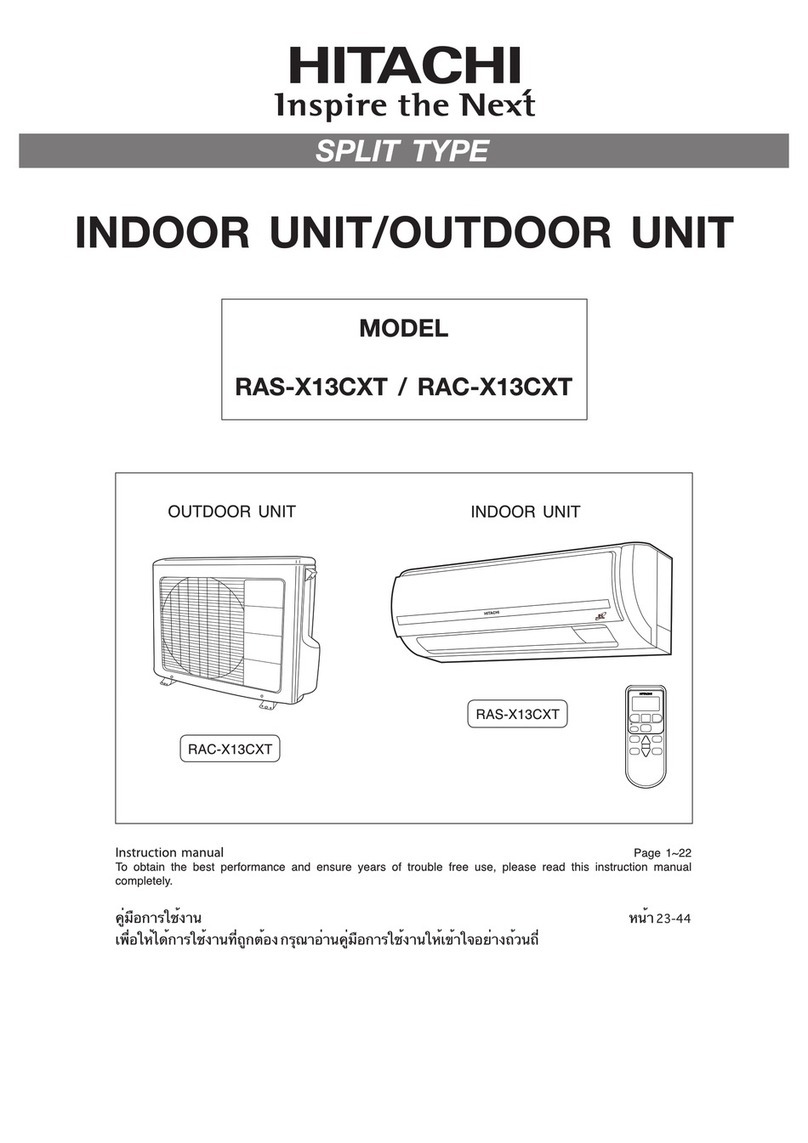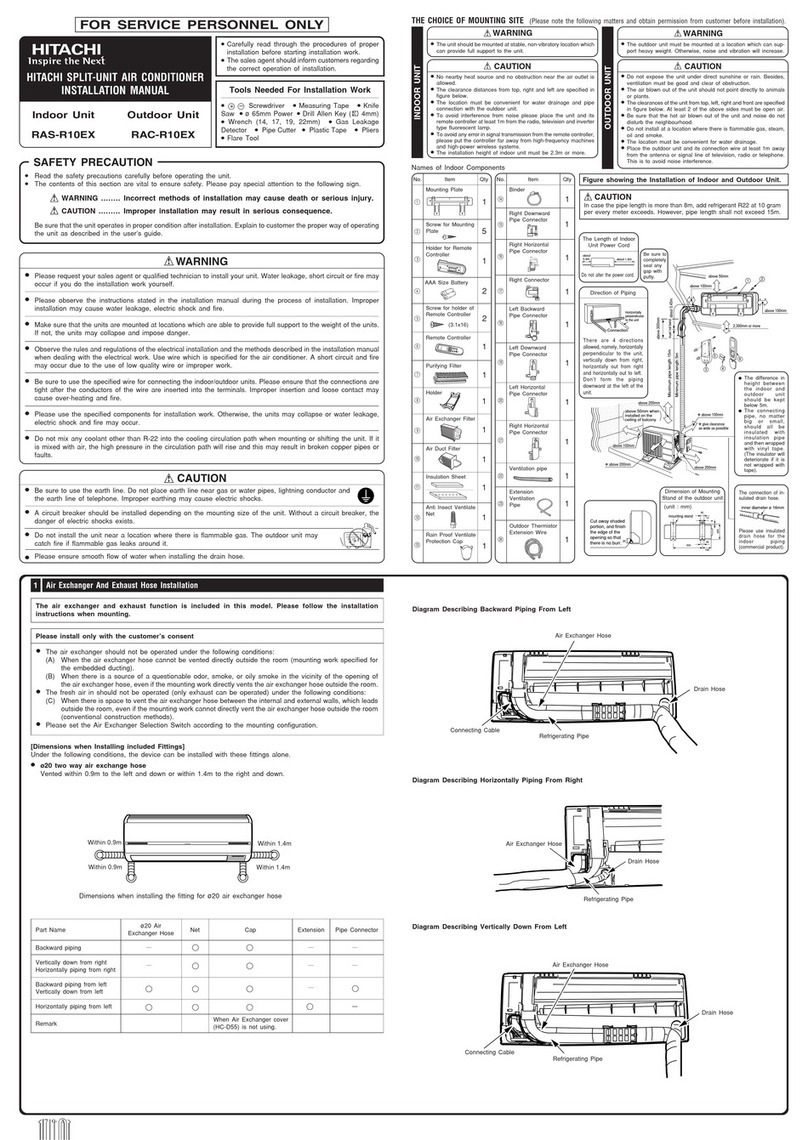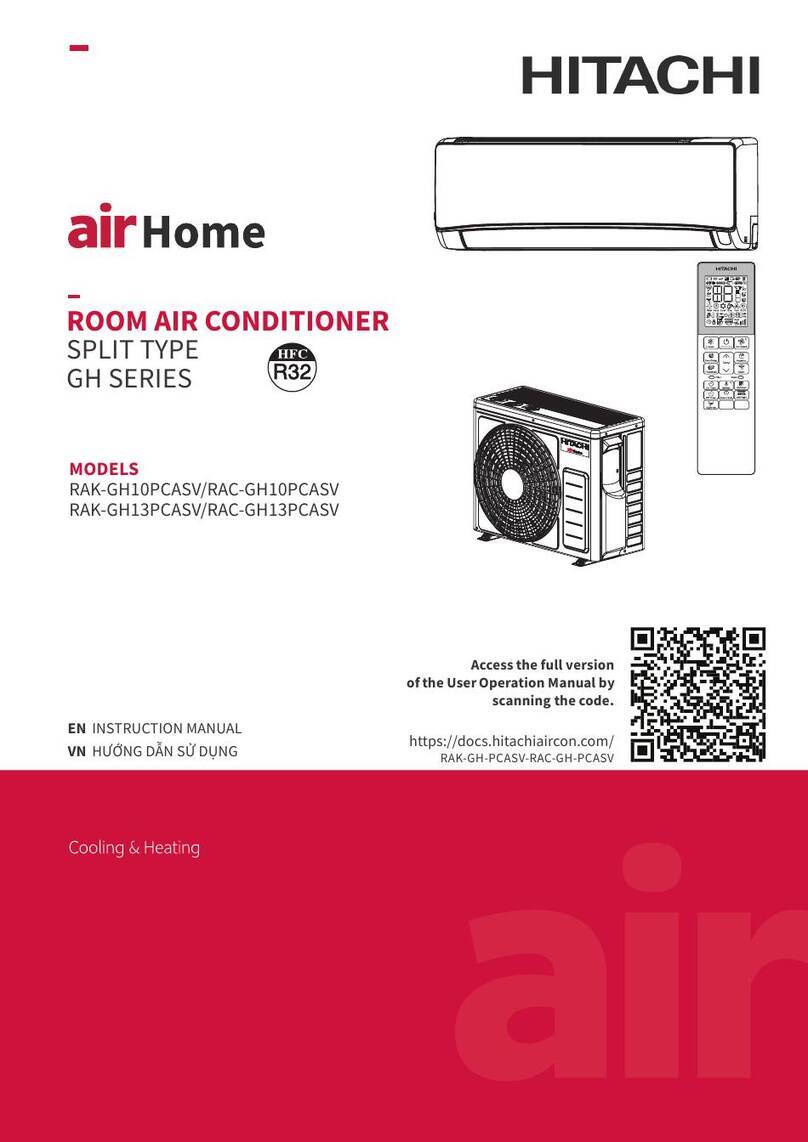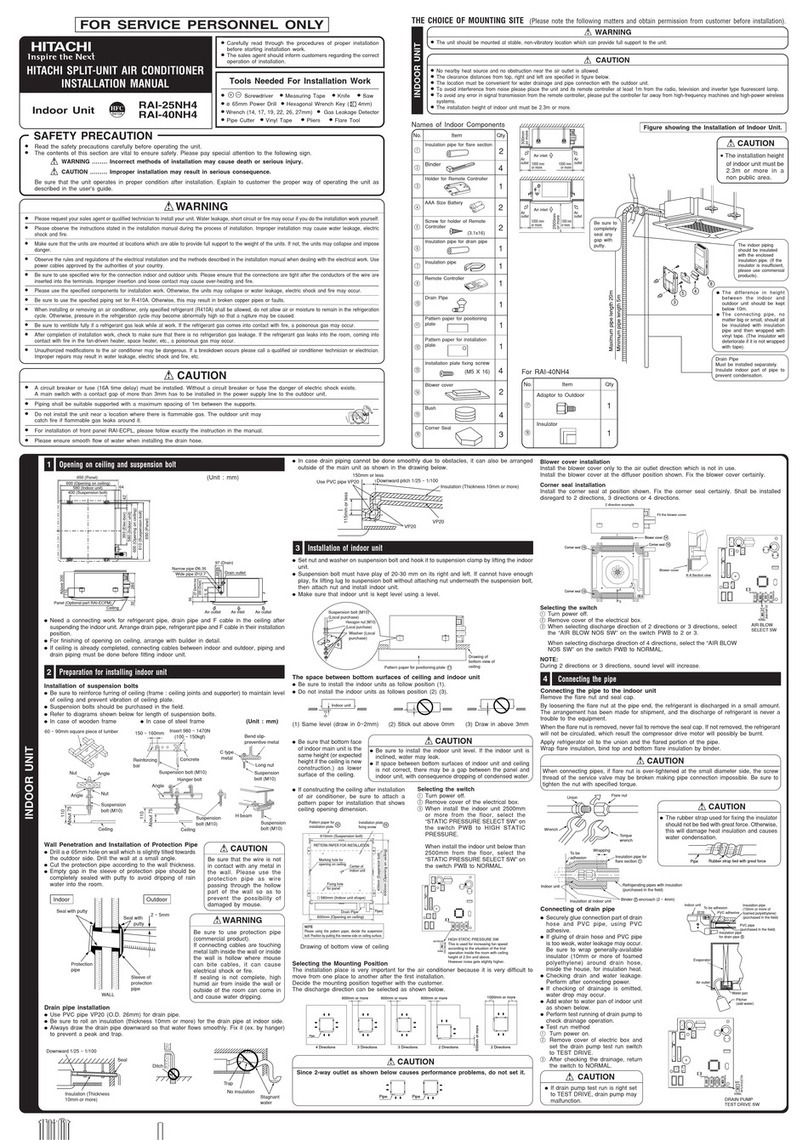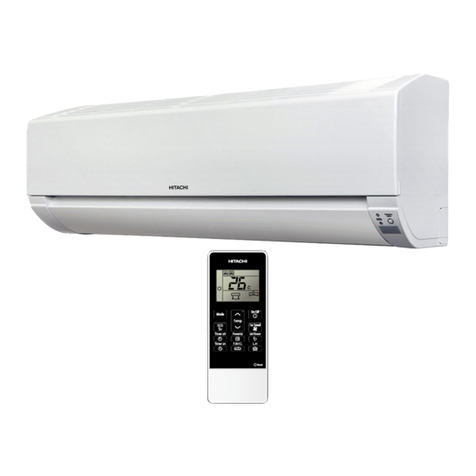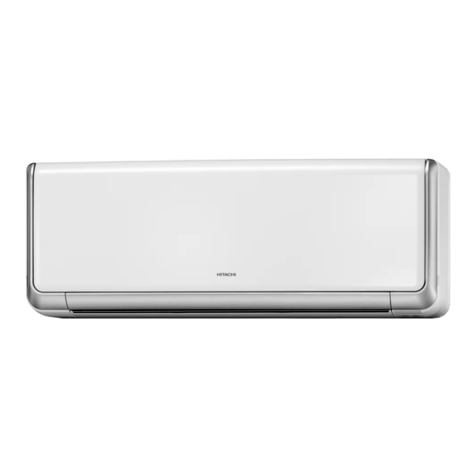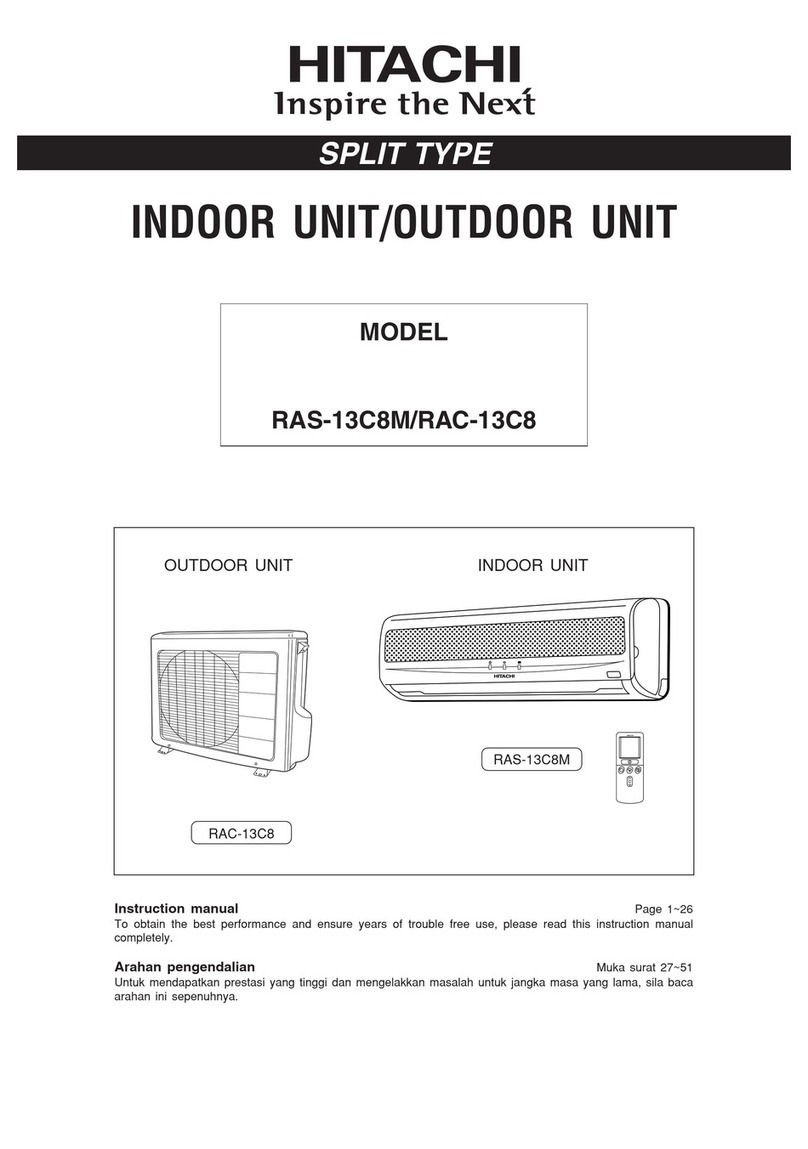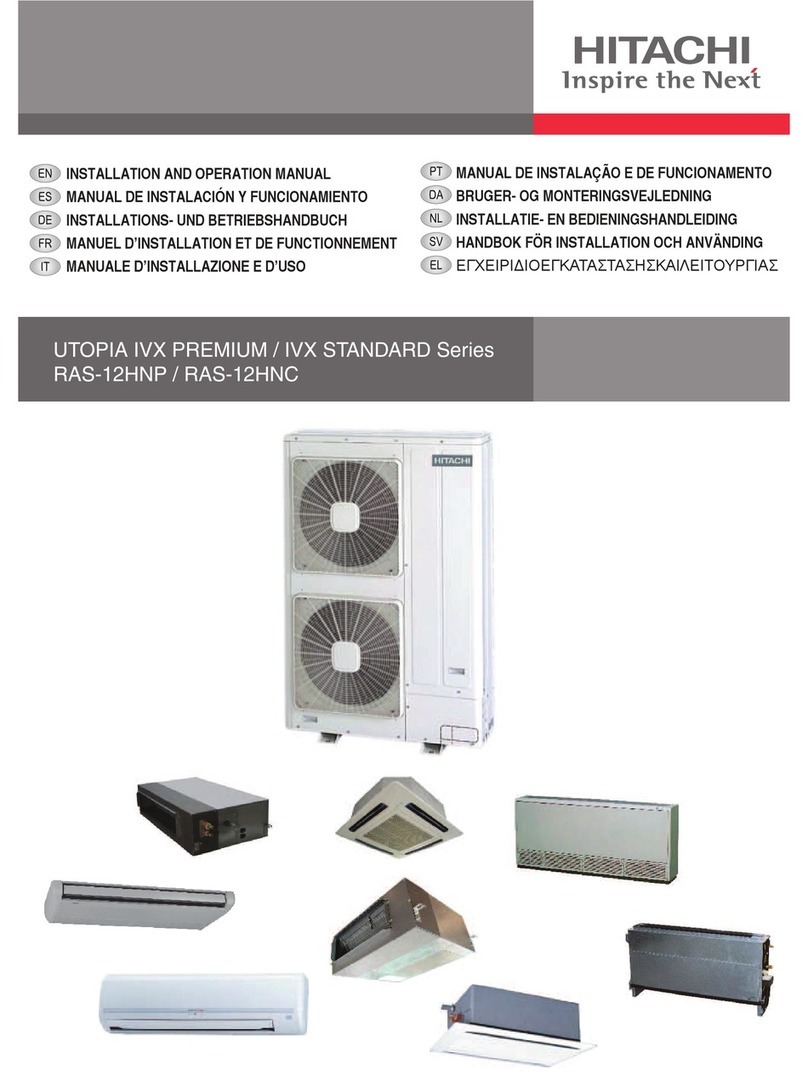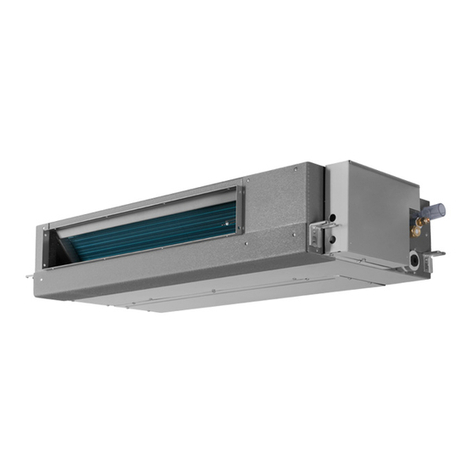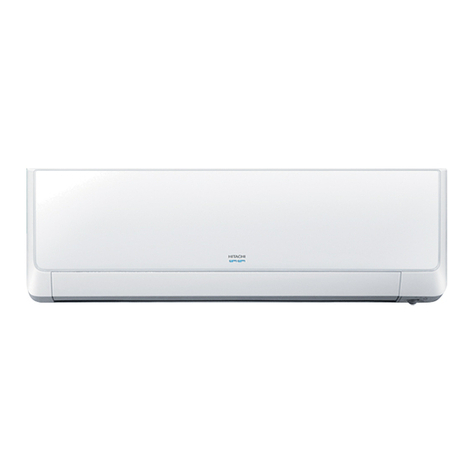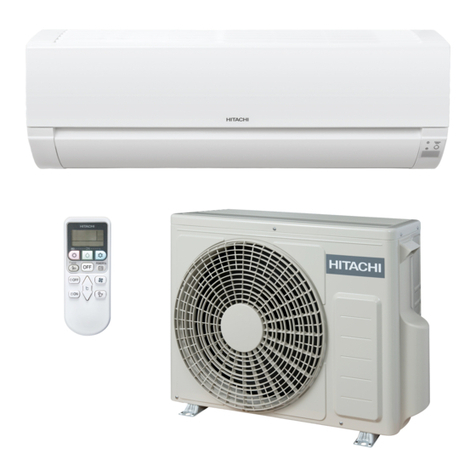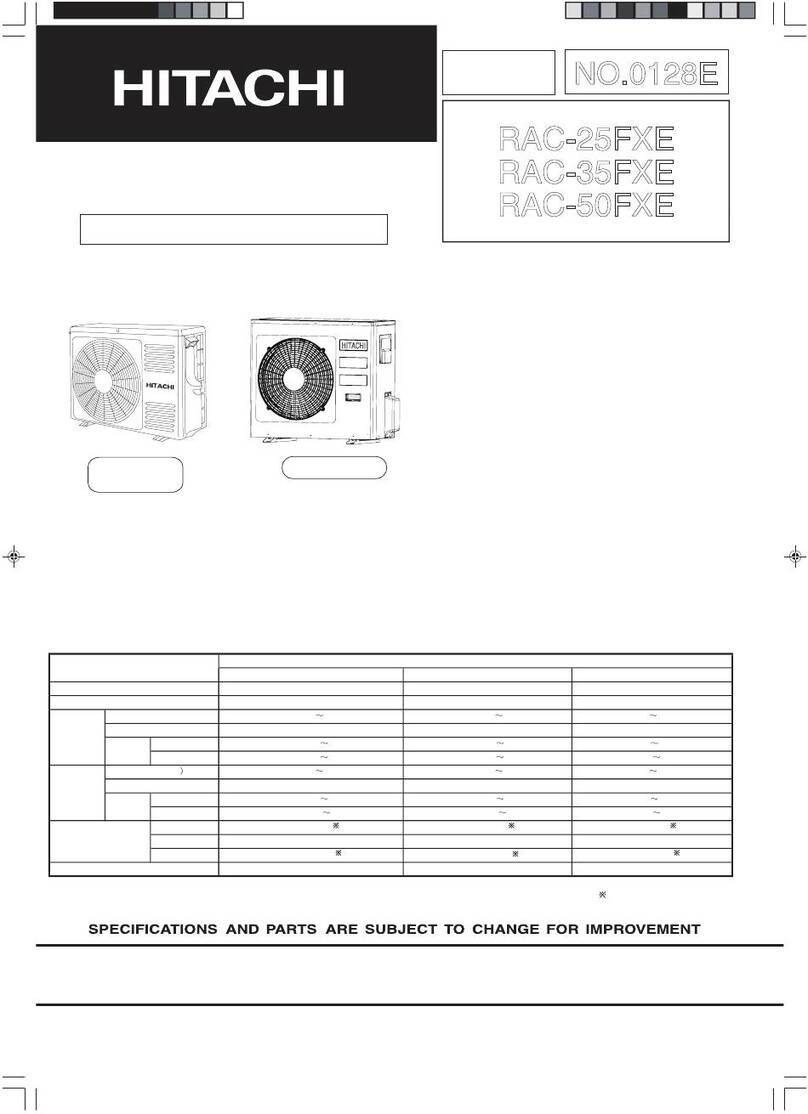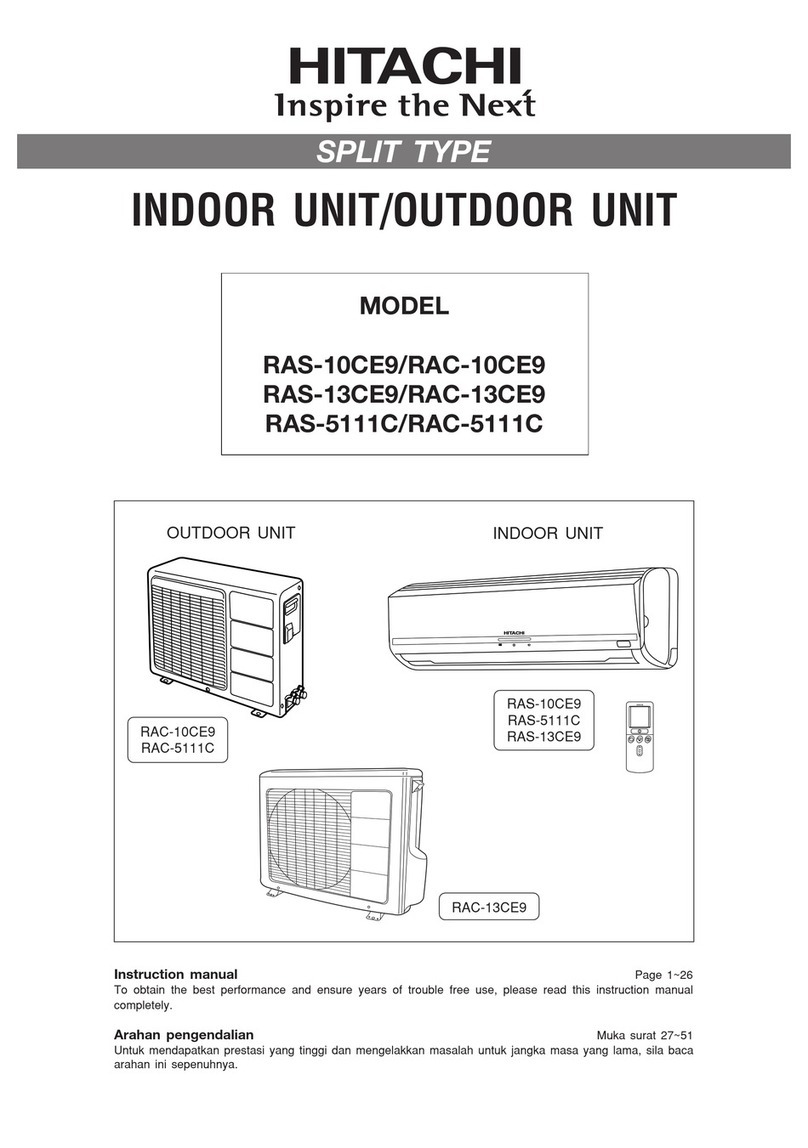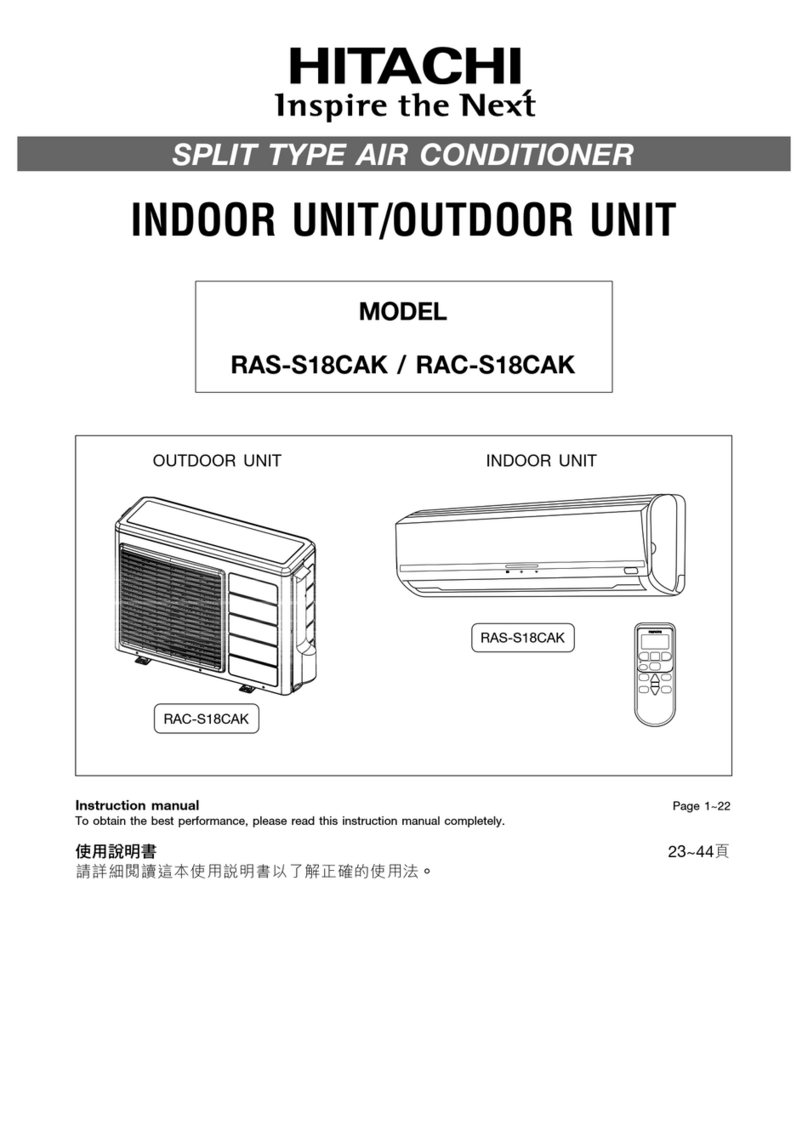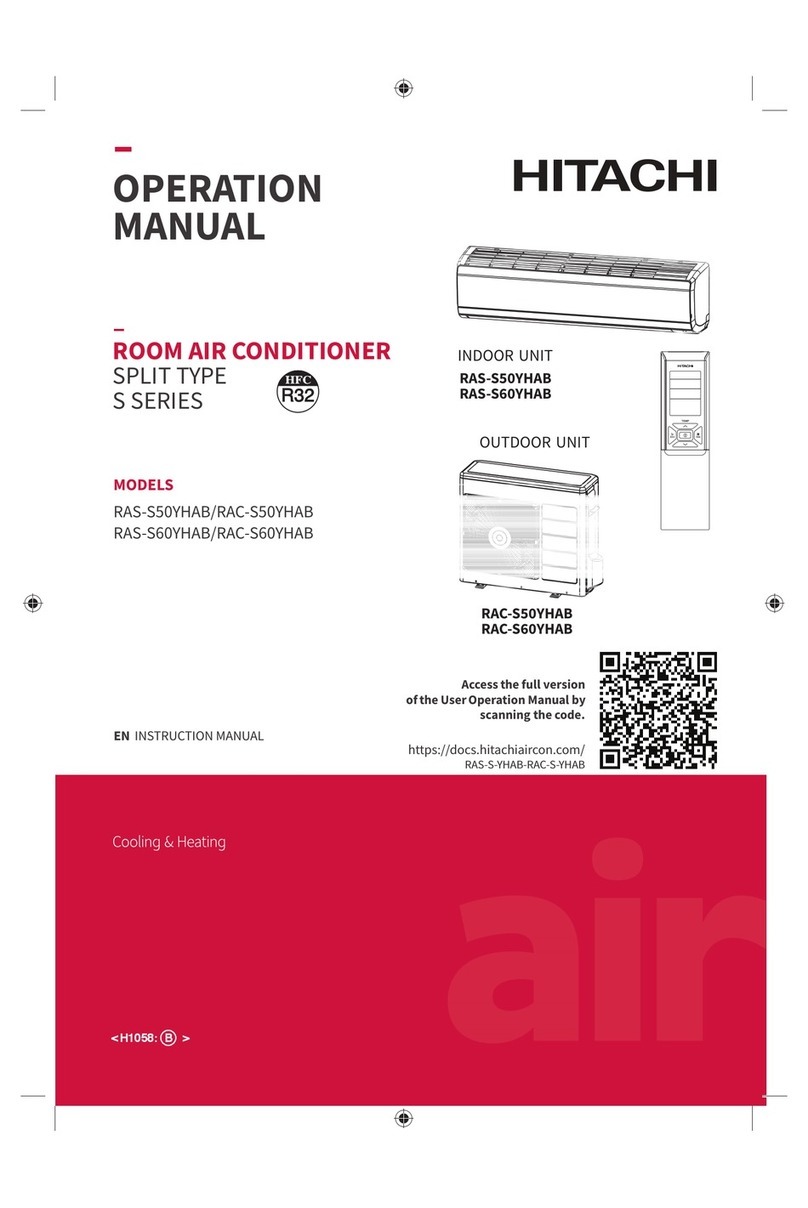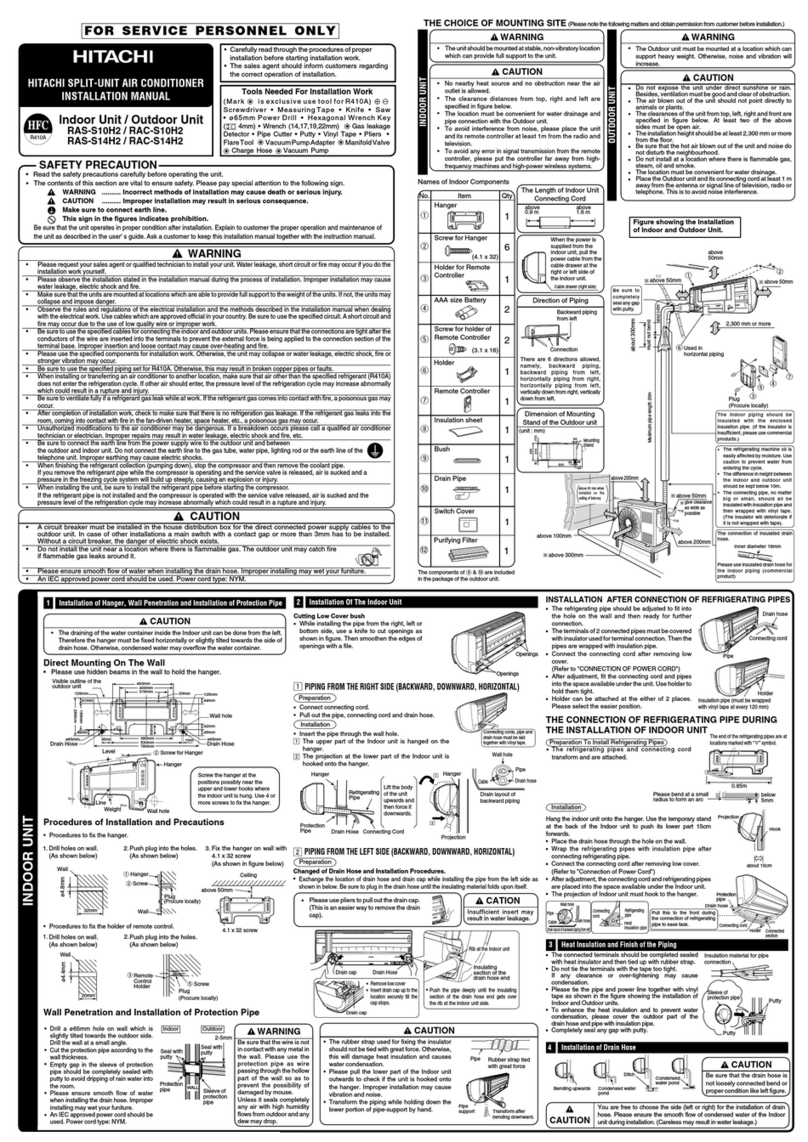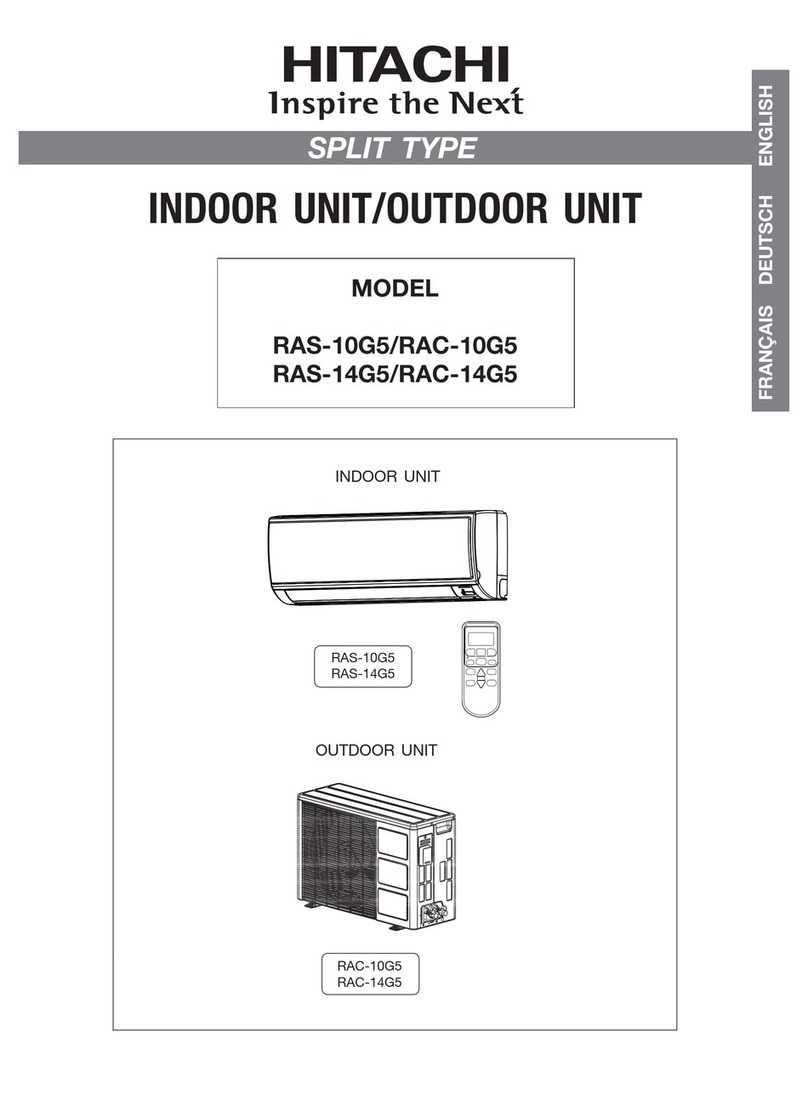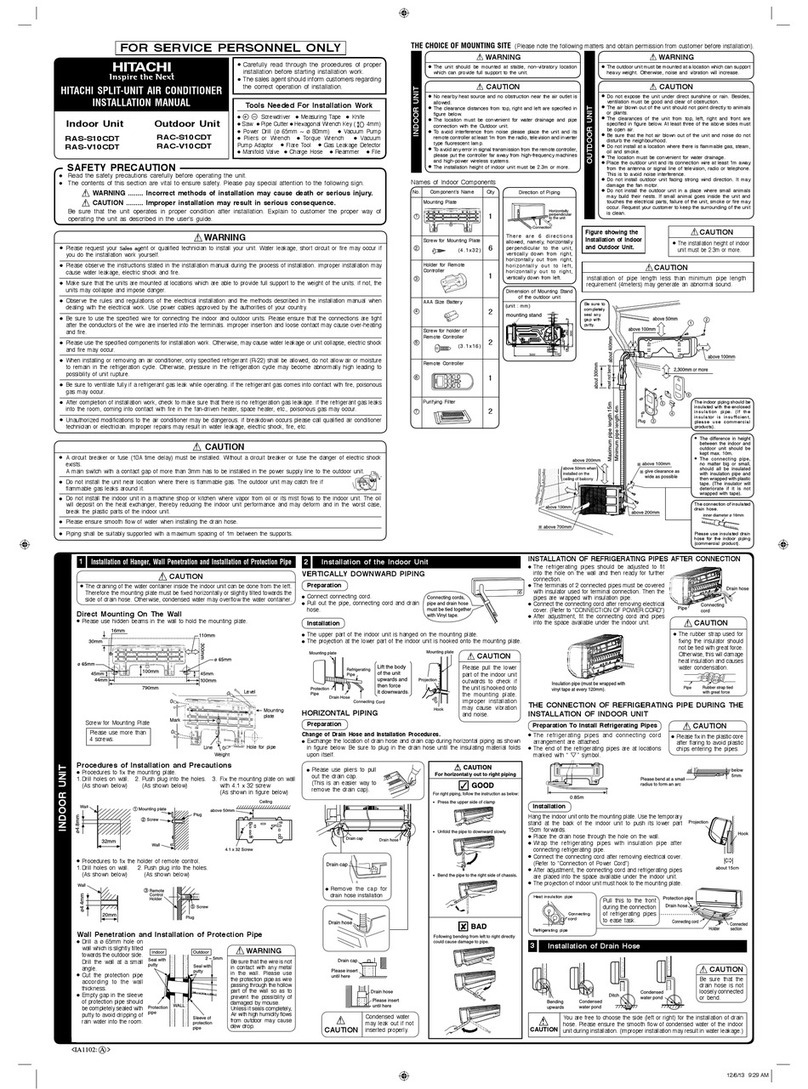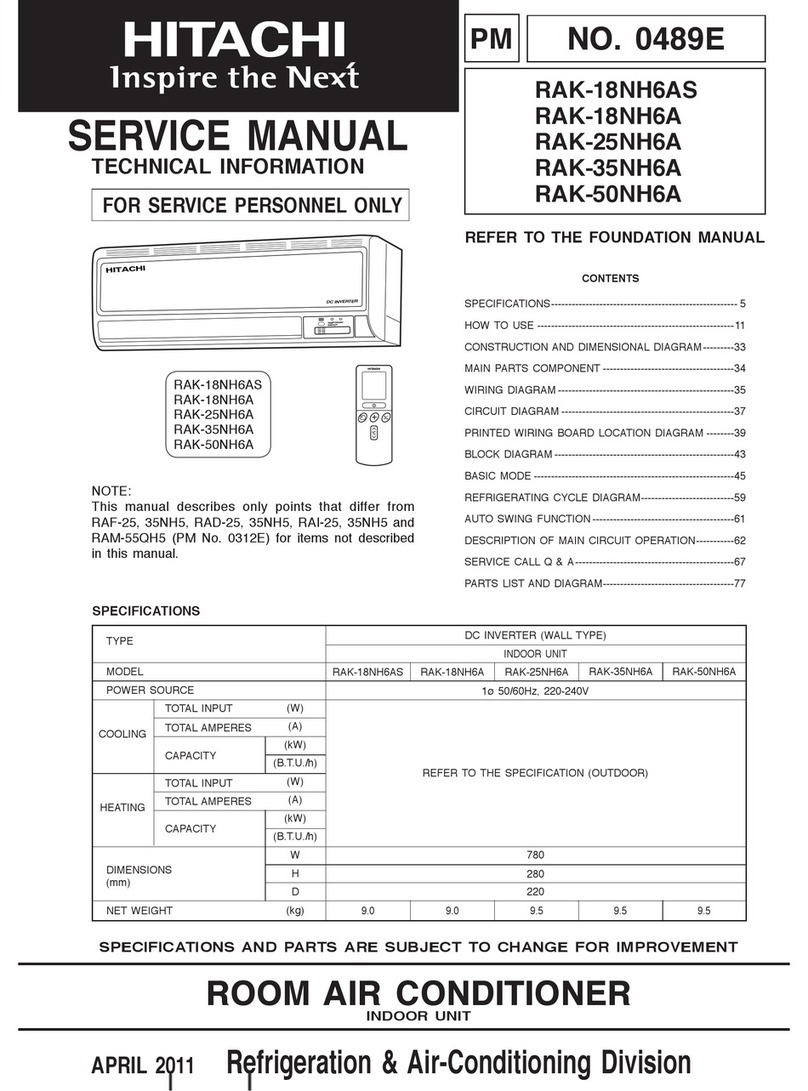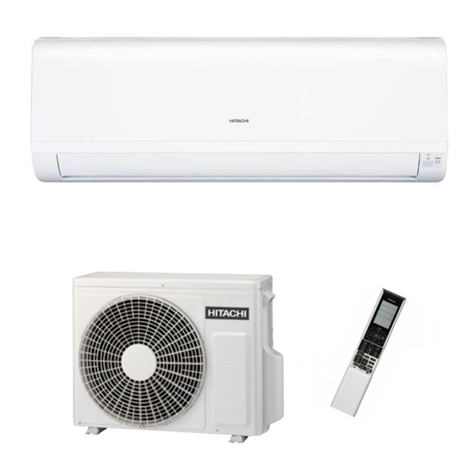
OUTDOOR UNIT
●Please mount the Outdoor unit on stable ground to prevent vibration
and increase of noise level.
●Decide the location for piping after sorting out the different types of
pipe available.
●When removing side cover, please pull the handle after undoing the
hook by pulling it downward.
1
●Use a pipe cutter to cut
the copper pipe.
●Jagged edge will cause leakage.
●Point the side to be trimmed downwards during trimming to prevent
copper chips from entering the pipe.
●Before flaring, please put on the flare nut.
2
INSTALLATION OF REFRIGERATING PIPES AND AIR REMOVAL
CAUTION
!
Please face this side (suction side)
of the unit to the wall.
Please remove side cover
when connecting the piping and
connecting cord.
Pull downward
BASE
●Recommend to use
R32 flaring tool.
CAUTION
!
In case of removing flare nut of an Indoor unit, first
remove a nut of small diameter side, or a seal cap of
big diameter side will fly out. Prevent water from entering
into the piping when working.
CONDENSED WATER DISPOSAL OF OUTDOOR UNIT
●There are holes on the base of Outdoor unit for condensed
water to exhaust.
●In order to flow condensed water to the drain, the unit is installed on a
stand or a block so that the unit is 100mm above the ground as shown
figure. Join the drain pipe to one hole.
●At first insert one portion of the hook to the base (Portion A), then pull the
drain pipe in the direction shown by the arrow while inserting the hook
into the base. After installation, check whether the drain pipe cling to the
base firmly.
When Using and Installing In Cold Areas
When the air conditioner is used in low temperature and in snowy
conditions, water from the heat exchanger may freeze on the base surface
to cause poor drainage. When using the air conditioner in such areas, do
not install the bushings. Keep a minimum of 250mm between the drain
hole and the ground. When using the drain pipe, consult your sales agent.
For more details, refer to the installation Manual for Cold Areas.
DRAIN PIPE
100 mm ABOVE
BUSH BUSH
DRAIN PIPE
Trimming tool
Copper pipe
Die
Die
Copper pipe
Flare nut
Torque
wrench
Wrench
Gas Leakage Inspection
Please use gas leakage detector
to check if leakage occurs at the
connection of Flare nut as shown
on the right.
If gas leakage occurs, further tighten
the connection to stop leakage. (Be
sure to use R32 detector)
3
When the meter reaches - 101KPa
(-76cmHg) during pumping, fully tighten
the shuttle.
Closed
R32
Valve
Charge hose
Vacuum
pump
adapter
When pumping starts, slightly loosen
the flare nut to check of air sucked in.
Then tighten the flare nut.
Vacuum
pump
Manifold valve
Meter showing pressure
Valve
Cap of valve head
Cap of valve head
The body of
service valve
Hexagonal
Wrench Key
Cap of valve
core
Outer
Diameter
mm (inch)
6.35 (1/4")
9.52 (3/8")
12.70 (1/2")
1.0 ~ 1.5
1.0 ~ 1.5
1.0 ~ 1.5
Clutch type
A (mm)
1.5 ~ 2.0
1.5 ~ 2.0
1.5 ~ 2.5
Wing nut type
Thickness
(mm)
0.8
0.8
0.8
0.0 ~0.5
0.0 ~0.5
0.0 ~0.5
Flare tool for R32
Clutch type
Conventional flare tool
●Prevent moisture from entering pipe connection.
●Refrigerating machine oil not be applied to the
outside of the flare.
When refrigerating machine oil is applied to the
outside of the flare, excessive tightening of the
flare nut, cracking of the flare nut, destruction of
the flare and gas leakage may occur.
●When using the control valve, do not use
deteriorated packing. And, do not overtighten the
steering wheel.
Gas leakage from the service valve part, stagnation,
touching fire, rarely cause ignition.
CAUTION
CONNECTION OF POWER CORD
Procedures of Wiring
●The naked part of the wire core should be 10 mm and fix it to the terminal tightly. Then try to pull the individual wire to check if
the contact is tight. Improper insertion may burn the terminal.
●Be sure to use only wire specified for the use of air-conditioner.
●Please refer to the manual for wire connection and the wiring technique should meet the standard of the electrical installation.
●There is an AC voltage drop between the LN terminal if the power is on. Therefore, be sure to remove the plug from its socket.
WARNING
!
!
●Leave some space in the connecting
cord for maintenance purpose and
be sure to secure it with the cord
band.
●Secure the connecting cord along
the coated part of the wire using the
cord band. Do not exert pressure
on the wire as this may cause
overheating or fire.
Wiring of The Outdoor Unit
●Please remove the side cover for wire connection.
WARNING
●If you cannot attach the side cover due to the connection cord, please press the connecting cord in the
direction to the front panel to fix it.
●Be sure that the hooks of the side cover is fixed in certainly. Otherwise water leakage may occur and this
causes short circuit or faults.
●The connecting cord should not touch to service valve and pipes. (It becomes high temperature in heating
operation.)
●Before installation, the power source must be checked and necessary wiring work must be completed. To make the wiring
capacity proper, use the wire gauge list below for the wiring from house distribution fuse box to the outdoor unit in consideration
of the locked rotor current.
●Investigate the power supply capacity and other electrical conditions at the installing location.
Depending on the model of room air conditioner to be installed, request the customer to make arrangements for the necessary
electrical work etc.
The electrical work includes the wiring work up the outdoor unit . In localities where electrical conditions are poor, use of a
voltage regulation is recommended.
●Install outdoor for the room air conditioner within the reaching range of the line cord.
WARNING
Checking for the electric source and the voltage range
Fig. 1-2
Circuit Breaker
20A
Arrange power cord so they do
not touch service valve.
Bind connecting cords to make
them fit between the convex
sections.
Grounding rod (optional)
(Earth wire and grounding rod are not supplied. Please use optional items below.)
Earth line
IMPORTANT
Type of grounding rod
SP-EB-2
Length
900mm
CAUTION
!
WARNING
●Connect the Connecting Cord to “Indoor 1 (1, 2, 3) for indoor unit 1,
“Indoor 2 (1, 2, 3) for indoor unit 2, “Indoor 3 (1, 2, 3) for indoor 3.
!
Fig. 1-3
Note:
●Outdoor supply cords shall not
be lighter than polychloroprene
sheathed flexible cord with code
designation 60245 IEC 57.
!
CAUTION
Cable type
3 Core
Cable type
4 Core
Cable length
up to 25m
Wire cross-section
2.5mm2
Wire cross-section
1.5mm2
IMPORTANT
For (Power cord - L, N, Earth)
For (Connecting cord - 1, 2, 3, Earth)
!
●THIS APPLIANCE MUST BE EARTHED.
Fig. 1-1
Indoor earth wire connection to outdoor
Method 1 (Separate)
From Indoor 1 From Indoor 1From Indoor 2
Screw for ground at outdoor unit Screw for ground at outdoor unit
From Indoor 2
Method 2 (Combine)
Both method of earth wire connection are acceptable.
Please ensure the wire fixed firmly to the screw.
Outer
dia.of pipe
6.35 (1/4")
9.52 (3/8")
12.70 (1/2")
6.35 (1/4")
9.52 (3/8")
12.7 (1/2")
6.35 (1/4”)
9.52 (3/8”)
12.7 (1/2”)
15.87 (5/8”)
Spindle
Valve
head cap
Torque N·m
(kgf
·
cm)
14.0 – 18.0 (140 ~ 180)
33.0 – 42.0 (330 ~ 420)
50.0 – 62.0 (500 ~ 620)
19.6 – 24.5 (200 ~ 250)
19.6 – 24.5 (200 ~ 250)
29.4 – 34.3 (300 ~ 350)
12.3 – 15.7 (125 ~ 160)
3.92~5.88 (40~60)
9.80~10.78 (100~110)
Small dia. side
Large dia. side
Valve core cap
Small dia. side
Large dia. side
Small dia. side
Large dia. side
FINAL STAGE OF INSTALLATION
Insulation And Maintenance Of Pipe Connection
●The connected terminals should be completely sealed with heat insulator
and then tied up with rubber strap.
●Please tie the pipe and power line together with vinyl tape as shown in the
figure showing the installation of Indoor and Outdoor units. Then fix their
position with holders.
●To enchance the heat insulation and to prevent water condensation, please
cover the outdoor part of the drain hose and pipe with insulation pipe.
●Completely seal any gap with putty.
1
Insulation material for pipe connection
Putty
Putty
Sleeve of
protection pipe
Power Source And Operation Test
2
Power Source
WARNING
●Never remodel the power plug nor extend the long-distance
cord.
●Keep additional length for the power cord and do not render
the plug under external force as this may cause poor contact.
●Do not fix the power cord with U-shape nail.
●The power cable easily generates heat. Do not bring the cable
together with a wire or vinyl tie.
Operation Test
CAUTION
●Don't operate for over 5 minutes with the
situation that the spindle of the service
valve is closed. This will cause the defect.
●Don't operate by Cool Mode or Dry Mode
with the door and windows opened, (the
room humidity is always above 80%) for
a long period of time. Water will condense
and drip down occasionally. This will wet
your furniture.
●Explain to your customer the proper operation
procedures as described in the user' s manual.
●If the indoor unit won't operate, check the
cable for correct connection.
●Turn on the lamp in the room where the
indoor unit is installed and check the remote
controller for normal operation.
3. Operate the air conditioner for 20 minutes at least
and make sure that the air from the air conditioner
is cool or warm.
4. Press the ON/Off button on the remote controller
to make sure that the air conditioner stops running.
●If the indication lamps of the indoor unit blink with
sounding the buzzar during the operation test, perform
a check following the procedures below.
●Before the check and the reoperation, reset the power
supply by turning off and on the circuit breaker only
after:-
1. waiting for at least 5 mintes; or
2. pressing the Temporary Switch Button only once
while the power is OFF.
Indication lamps
blinking mode What do check
All indication lamps
blink three times
repeatedly.
Make sure that the spindles of
both service valves are open.
(Outdoor fan might operate
for near 15 minutes after the
operation stop for the protection.
For the reoperation at that case,
do it after outdoor fan will stop.)
●Please be sure to measure the supply voltage before operation
test.
●Please ensure that the air conditioner is in normal operating condition
during the operation test.
1. Operate with Cool Mode(in summer) or Heat Mode(in winter).
2. Press Temperature Button on the remote controller to set the
desired temperature to 16.0°C for Cool Mode or 32.0°C for
Heating Mode.
Set the desired fan speed to " "(High).
CAUTION
●Trial run should be conducted on one unit
at a time to check for incorrect wiring of
connecting cord.
<IA2327: A >
Detail of Cutting the Connecting Cord
1. Installation procedure and notice
Especially, the selection of installation place
need great care for the split type air conditioner,
because it is very difficult to move from place to
place after the first installation.
1.1 Wiring
(1) Connect the electrical wiring between the
Indoor and Outdoor unit, as shown in
Fig. 1-1. Never connect the wiring by
mistake.
In case of wrong connection, the unit
does not operate properly and it may
cause malfunction.
(2) The connecting cord must be fixed by the
band which is located near the terminal
board.
1.2 Connection of the connecting cords
and power cord
(1) Cut off the connecting cord, the power
cord and strip the insulation of the wire, as
shown in Fig. 1-2.
(2) Connect the connecting cord and power
cord to the terminal board. (Fig. 1-3)
(3) Fix the connecting cords and power cord
with steel band certainly. (Fig. 1-3)
Preparation of Pipe
Pipe Connection
Removal Of Air From The Pipe And Gas Leakage Inspection
AIR REMOVAL
Procedures of using Vacuum Pump
for Air Removal
As shown in right figure, remove the cap of
valve core. Then, connect the charge hose.
Remove the cap of valve head. Connect the
vacuum pump adapter to the vacuum pump
and connect the charge hose to the adapter.
Fully tighten the “Hi” knob of the manifold
valve and completely unscrew the “Lo” knob.
Run the vacuum pump for about 10~15
minutes, then completely tighten the “Lo” knob
and switch off the vacuum pump.
2
Completely unscrew the spindle of the
service valve in anti-clockwise direction to
allow the flow of refrigerant (using Hexagonal
Wrench key).
Re-cap the service valve and tighten using
wrench. Check the cap’s periphery if there is
any gas leakage. The task is then completed.
Remove the charge hose and tighten the cap
of valve core. Check the cap’s periphery if
there is any gas leakage.
4
5
1
3
